List of dining events

This is a list of historic and contemporary dining events, which includes banquets, feasts, dinners and dinner parties. Such gatherings involving dining sometimes consist of elaborate affairs with full course dinners and various beverages, while others are simpler in nature.
Banquets[]

- Banquet of Chestnuts – known more properly as the "Ballet of Chestnuts", refers to a fête in Rome, and particularly to a supper purportedly held in the Papal Palace by former Cardinal Cesare Borgia, son of Pope Alexander VI on 30 October 1501.
- Banquet of the Five Kings – a 1363 meeting of the kings of England, Scotland, France, Denmark and Cyprus
- Julebord – a Scandinavian feast or banquet in the days before Christmas in December and partly November where there is served traditional Christmas food and alcoholic beverages, often in the form of a buffet. Many Julebords are characterized by large amounts of food and drink, both traditional and new, hot and cold dishes. There is often lively partying and the party can be an important social meeting place for colleagues.
- Nobel Banquet – an annual banquet held on 10 December in the Blue Hall of Stockholm City Hall, after the Nobel Prize ceremony.[1] At the banquet, for which a formal dress code exists, a multi-course dinner is served and entertainment provided.[2]
Breakfasts[]
- North Melbourne Grand Final Breakfast – a breakfast function organised by the North Melbourne Football Club on the morning of the AFL Grand Final
- NRL Grand Final Breakfast – a breakfast function organised by the National Rugby League on the week of the NRL Grand Final
- Pancake breakfast – a public meal attached to many summer festivals and community events in the United States and Canada which involves volunteers cooking large quantities of pancakes and other hot breakfast foods for the general public.
Dinners[]

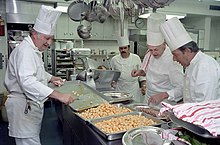
- Bracebridge Dinner – a seven-course formal gathering at the Ahwahnee Hotel[3] presented as a feast given by a Renaissance-era lord. Started in 1927, the Ahwahnee's first year of operation, the dinner is inspired by the fictional Squire Bracebridge's Yule celebration in a story from The Sketch Book of Geoffrey Crayon, Gent. by Washington Irving.
- Christmas dinner – a meal traditionally eaten at Christmas, which can take place any time from the evening of Christmas Eve to the evening of Christmas Day itself
- Kūčios – the traditional Christmas Eve dinner in Lithuania, held on the twenty fourth of December
- Passover Seder - dinner during the Jewish celebration of Passover. Usually held with family and friends. During the dinner, the host reads the Haggadah, which tells the story of Jewish enslavement in Egypt and their liberation by God through Moses. The story is considered a central part of Jewish identity.
- Progressive dinner – called a progressive dinner in the U.S. and a safari supper in the U.K., it is a dinner party with successive courses prepared and eaten at the residences of different hosts. Usually this involves the consumption of one course at each location. An alternative is to have each course at a different dining area within a single large establishment.
- Pennsylvania Society Dinner – the main event of The Pennsylvania Society's annual weekend retreat
- Reunion dinner – held on New Year's Eve of the Chinese Lunar New Year, during which family members get together to celebrate. It is often considered the most important get-together meal of the entire year.
- Réveillon – a long dinner held on the evenings preceding Christmas Day and New Year's Day. This occurs in various areas of the world.
- Rock Dinner – a series that aired on MTV Tr3s that let people in the Los Angeles area have the opportunity to cook dinner for their favorite Latino artist[4]
- State dinner – a dinner or banquet paid for by a government and hosted by a head of state in his or her official residence in order to renew and celebrate diplomatic ties between the host country and the country of a foreign head of state or head of government who was issued an invitation. It may form part of a state visit or diplomatic conference. State lunches also occur.
- List of U.S. State Dinners
- State Dining Room of the White House
- Thanksgiving dinner – the centerpiece of contemporary Thanksgiving in the United States and Canada is a large meal, generally centered on a large roasted turkey which is only enjoyed once per year. The majority of the dishes in the traditional American version of Thanksgiving dinner are made from foods native to the New World, as according to tradition the Pilgrims received these food from the Native Americans.[5]
- Three Emperors Dinner – a banquet held at Café Anglais in Paris, France on 7 June 1867.[6] It was prepared by chef Adolphe Dugléré and consisted of 16 courses with eight fine wines served over eight hours. The dinner was prepared at the request of King William I of Prussia and was attended by King William I, Tsar Alexander II of Russia and his son the tsarevitch (who later became Tsar Alexander III), and Prince Otto von Bismarck.
- Thursday Dinners – meetings of artists, intellectuals, architects, politicians and statesmen held by the King of Poland, Stanisław II August in the era of Enlightenment in Poland
- Trefa Banquet
- Wild onion dinner – social gatherings held in the spring by various Native American tribes in Oklahoma, especially southeastern tribes.[7] The meals focus on the spring appearance of wild onion, a food that was familiar to most of the tribes east of the Mississippi.
- Dinners

Jimmy Carter toasts Carlos Andres Perez, the President of Venezuela, during a state dinner
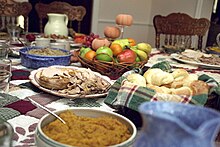
Foods at a Thanksgiving dinner

The chamber where the dignitaries would dine and meet with King Stanisław August Poniatowski at Thursday Dinners
The White House[]

- Booker T. Washington dinner at the White House – On 16 October 1901, shortly after moving into the White House, Theodore Roosevelt invited his adviser, the African American spokesman Booker T. Washington, to dine with him and his family, and provoked an outpouring of condemnation from southern politicians and press.[8] This reaction affected subsequent White House practice, and no other African American was invited to dinner for almost thirty years.[9]
- White House Correspondents' Dinner – first occurring in 1921,[10] it has become a Washington, D.C. tradition and is traditionally attended by the president and vice president.[11] Fifteen presidents have attended at least one White House Correspondents' Association dinner, beginning with Calvin Coolidge in 1924.[11] The dinner is traditionally held on the evening of the last Saturday in April at the Washington Hilton.
- White House Iftar dinner – an annual reception held at the White House and hosted by the U.S. President and the First Lady to celebrate the Muslim month of Ramadan. Discontinued by President Donald Trump in 2017 [12] and then reestablished at the White House on June 6, 2018.[13]
Feasts[]

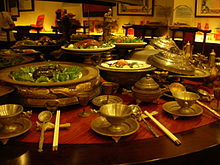
- Bean-feast – was primarily an annual dinner given by an employer to his or her employees.[14] By extension, colloquially, it describes any festive occasion with a meal and an outing.[15]
- Boar's Head Feast – a festival of the Christmas season
- Commercium – a traditional academic feast known at universities in most Central and Northern European countries
- Feast at Hong Gate
- Feast of the Pheasant – a banquet given by Philip the Good, Duke of Burgundy on 17 February 1454 in Lille, now in France. Its purpose was to promote a crusade against the Turks, who had taken Constantinople the year before. The crusade never took place.
- Feast of the Seven Fishes – an Italian-American celebration of Christmas Eve with meals of fish and other seafood.[16]
- Karamu – a feast that takes place on December 31, the sixth day of the Kwanzaa period
- Manchu Han Imperial Feast – one of the grandest meals ever documented in Chinese cuisine, it consisted of at least 108 unique dishes from the Manchu and Han Chinese culture during the Qing dynasty, and it is only reserved and intended for the Emperors. The meal was held for three whole days, across six banquets. The culinary skills consisted of cooking methods from all over Imperial China.[17]
- Mesoamerican feasts – Feasts in Mesoamerica served as settings for social and political negotiations. Wealthy or royal families hosted feasts for the purpose of gaining loyalty and a strong image that would help them politically or socially in the future. People of every social status hosted feasts as a celebration of family and life.
- Oyster Feast – the centrepiece of the annual civic calendar in the ancient borough of Colchester located in Essex in the East of England.
- Supra – a traditional Georgian feast and an important part of Georgian social culture. There are two types of supra: a festive supra called a keipi and a sombre supra called a kelekhi, that is always held after burials.
- Tableround – a traditional academic feast known at universities in most Middle and Eastern European countries. At a tableround, tables usually are placed in the form of a U or a W, the participants drink beer and sing commercium songs. A more formal form of the tableround is the commercium.
Suppers[]
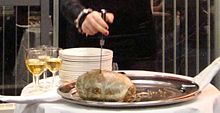
- Burns supper – a celebration of the life and poetry of the poet Robert Burns, the author of many Scots poems. The suppers are normally held on or near the poet's birthday, 25 January.[18] However, in principle, they may be held at any other time of the year.
- Last Supper – the final meal that, in the Gospel accounts, Jesus shared with his Apostles in Jerusalem before his crucifixion.[19]
- Pie supper – is a social gathering where pies are auctioned to raise money, often for a local school or fire department.
- Supper at Emmaus – The Road to Emmaus appearance is one of the early resurrection appearances of Jesus after his crucifixion and the discovery of the empty tomb.[20][21][22] Both the Meeting on the road to Emmaus and the subsequent Supper at Emmaus, depicting the meal that Jesus had with two disciples after the encounter on the road, have been popular subjects in art.
- Wigilia – the traditional Christmas Eve vigil supper in Poland, held on December 24
- Suppers
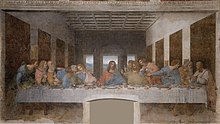
Depictions of the Last Supper have been undertaken by artistic masters for centuries; Leonardo da Vinci's late 1490s mural painting in Milan, Italy, being the best-known example.[23]

A 1601 painting of the Supper at Emmaus, by Caravaggio

A traditional Wigilia Christmas Eve supper
See also[]
References[]
- ^ "Nobelfesten -Ceremonin". Swedenabroad.com. Archived from the original on 24 September 2015. Retrieved 17 October 2014.
- ^ "Nobelfesten - Festen". Stockholm.se. Retrieved 17 October 2014.
- ^ "Get ready for Bracebridge, Yosemite's famous Christmas feast". Los Angeles Times. October 17, 2012.
- ^ "Rock Dinner". TV.com. July 15, 2013. Retrieved March 30, 2017.
- ^ Dickson, James G. (1992). The Wild Turkey: Biology and Management. National Wild Turkey Federation. Harrisburg, PA: Stackpole Books. p. 10. ISBN 978-0-8117-1859-2.
- ^ Frost, W.; Laing, J. (2016). Gastronomy, Tourism and the Media. Aspects of Tourism. Channel View Publications. p. 57. ISBN 978-1-84541-576-1.
- ^ Milbauer, John A. "Wild Onion Dinners." Oklahoma History Center's Encyclopedia of Oklahoma History and Culture. (retrieved 2 March 2010)
- ^ Gould, Louis L (28 November 2011). Theodore Roosevelt. USA: Oxford University Press. p. 45. ISBN 9780199797011.
His first action in October 1901 was to invite the prominent black leader Booker T. Washington to dine at the White House. [...] When the news of the social event became public, southern newspapers erupted with denunciations of Roosevelt's breach of the color line.
- ^ Lusane, Clarence (23 January 2013). The Black History of the White House. City Lights Publishers. p. 256. ISBN 9780872866119. LCCN 2010036925.
Although the controversy eventually died down, its impact shaped White House politics for decades. No black person would be invited to dinner at the White House again for nearly thirty years
- ^ Go to History of the WHCA (WHCA official website. Retrieved 2017-02-25.) and scroll down to "The Early Years (1914 - 1921)".
- ^ a b "Unfounded Leak Leads to Modern WHCA by George Condon, former president of the WHCA". White House Correspondents' Association. Retrieved August 20, 2012.
- ^ Delk, Josh (25 June 2017). "Trump breaks with tradition, forgoes Ramadan dinner". The Hill. Retrieved 25 June 2017.
- ^ Samuels, Brett (6 June 2018). "Trump hosts first iftar dinner". The Hill. Retrieved 6 June 2018.
- ^ Chisholm, Hugh, ed. (1911). . Encyclopædia Britannica. Vol. 3 (11th ed.). Cambridge University Press. p. 573.
- ^ From Merriam Webster Unabridged Dictionary
- ^ Clark, Melissa (16 December 2013). "Surf's Up on Christmas Eve. Feasting on Fish to the Seventh Degree". New York Times. Retrieved 2013-12-30.
It’s a Southern Italian (and now Italian-American) custom in which a grand meal of at least seven different kinds of seafood is served before midnight Mass The fish part comes from the Catholic practice of abstaining from meat on Christmas Eve, while the number may refer to the seven sacraments.
- ^ Hoover, Michael. Stokes, Lisa, Odham. (1999). City on Fire: Hong Kong Cinema. Verso publishing. ISBN 1-85984-203-8
- ^ "Forks & The Road: Hurling haggis for Robbie Burns Day". National Post. January 25, 2013. Retrieved 31 March 2017.
- ^ "Last Supper. The final meal Christ with His Apostles on the night before the Crucifixion.", Cross, F. L., & Livingstone, E. A. (2005). The Oxford Dictionary of the Christian Church (3rd ed. rev.) (958). Oxford; New York: Oxford University Press.
- ^ Luke by Fred B. Craddock 1991 ISBN 0-8042-3123-0 page 284
- ^ Exploring the Gospel of Luke: an expository commentary by John Phillips 2005 ISBN 0-8254-3377-0 pages 297-230
- ^ Luke 24
- ^ Gospel figures in art by Stefano Zuffi 2003 ISBN 978-0-89236-727-6 pages 254-259
- Dining events
- History of food and drink
- Food industry-related lists
- Rituals






